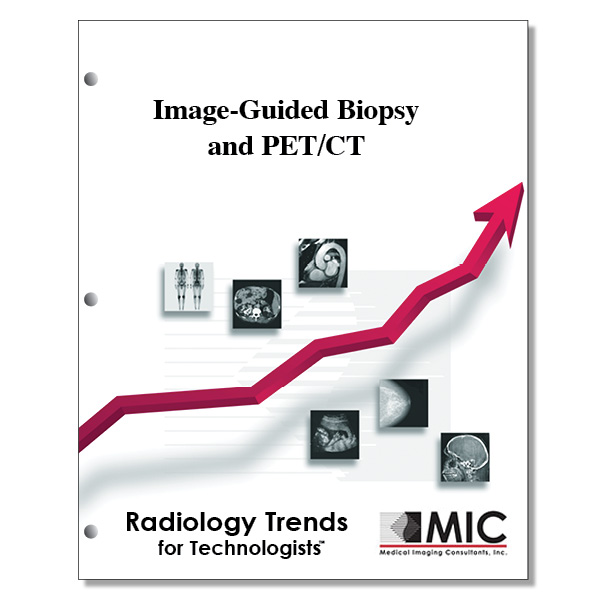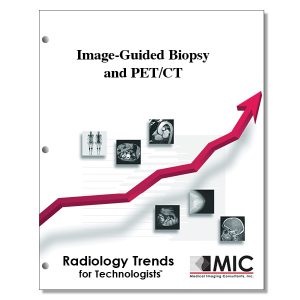

Image-Guided Biopsy and PET/CT
Benefits of using FDG PET/CT for image-guided biopsy are presented along with pitfalls to avoid.
Course ID: Q00346 Category: Radiology Trends for Technologists Modalities: CT, Nuclear Medicine, PET, Radiation Therapy3.0 |
Satisfaction Guarantee |
$34.00
- Targeted CE
- Outline
- Objectives
Targeted CE per ARRT’s Discipline, Category, and Subcategory classification:
[Note: Discipline-specific Targeted CE credits may be less than the total Category A credits approved for this course.]
Nuclear Medicine Technology: 2.25
Image Production: 0.25
Instrumentation: 0.25
Procedures: 2.00
Endocrine and Oncology Procedures: 2.00
Outline
- Introduction
- Mechanism of Cancer Imaging with FDG PETCCT
- Biologic Significance of FDG Uptake Relevant to Biopsy
- False-Positive FDG Uptake Relevant to Patient Selection for Biopsy
- Physiologic Distribution of FDG Uptake
- Normal Variations in FDG Uptake
- Brown Adipose Tissue
- Thymus
- Myocardium
- Spleen
- Skeletal Muscle
- Bone Marrow
- Benign Pathologic FDG Uptake Due to Infection and Inflammation
- FDG Uptake in Benign Tumors
- PET/CT-related Artifacts
- Applications of PET/CT Findings to Biopsy
- Lesions with Nonuniform FDG Uptake
- Multiple Lesions with Varying FDG Uptake
- Lesions Difficult to Target because of Underlying Anatomic Alterations
- Lesions with Few or No Morphologic Changes at Anatomic Imaging
- Pitfalls in Interpreting Biopsy Results on the Basis of PET/CT Findings
- Recent Advances in PET/CT-guided Biopsy
- Summary
Objectives
Upon completion of this course, students will:
- be familiar with PET/CT terminology
- understand how FDG is metabolized in the human body
- know the advantages of using FDG PET/CT for image-guided biopsy
- understand the decay mechanism for nuclei with excess protons
- understand how the positrons undergo annihilation
- be familiar with the physical half-life of 18F
- understand how FDG is transported in human cells
- identify noncancerous disorders that will increase FDG uptake
- understand the ideal properties of the crystals used in PET scanners
- know the characteristics that define a true event in a PET scanner
- understand what effects the overall number of random events in a PET scanner
- know how irradiation affects human tissue on FDG PET/CT scans
- be familiar with organs that have normal physiological FDG uptake
- identify which organs have normal physiological uptake in children and young adults
- be familiar with normal myocardial FDG uptake on PET/CT scans
- know the causes of FDG musculoskeletal uptake on PET/CT scans
- be familiar with the effects of GCSF and chemotherapy on the uptake of FDG
- understand the inability to distinguish certain types of cancers from infection on FDG PET/CT
- be familiar with FDG PET/CT uptake associated with a healing wound
- be familiar with FDG avid benign tumors associated with the neck
- be familiar with FDG avid benign tumors associated with the abdomen
- be familiar with FDG avid benign tumors associated with the bones
- identify the PET/CT-related artifacts created from using CT data
- identify the causes for PET/CT misregistration artifacts
- understand the causes for PET/CT attenuation artifacts
- be familiar with PET quality control tests
- be familiar with CT quality control tests
- identify the area of the body encompassed in a whole-body FDG PET/CT
- be familiar with the normal physiological uptake in organs in the human body
- understand the terminology related to SUVs
- identify causes of false negatives on FDG PET/CT scans
- be familiar with cancers that have inherently low FDG uptake on PET/CT scans
- understand how SUV is defined
- understand the effects that partial volume averaging may have on SUV results
- be familiar with the possibility of reoccurring disease from microscopic residual disease
- be familiar with the role of ultrasound when conducting a FDG PET/CT image-guided biopsy
- be familiar with counter indications for performing CT image-guided biopsy
- identify the risks associated with CT image-guided biopsy
- be familiar with the lack of specificity of FDG distribution when performing FDG PET/CT image-guided biopsy
- identify the causes for false positive results when performing FDG PET/CT image-guided biopsy
